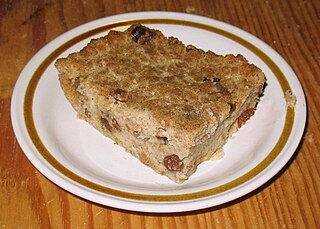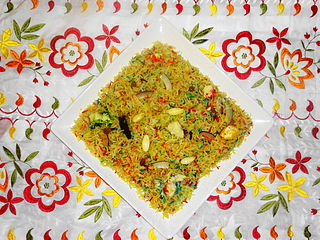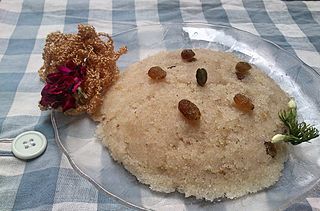
Bread pudding is a bread-based dessert popular in many countries' cuisines, made with stale bread and milk or cream, generally containing eggs, a form of fat such as oil, butter or suet, and depending on whether the pudding is sweet or savory, a variety of other ingredients. Sweet bread puddings may use sugar, syrup, honey, dried fruit, nuts, as well as spices such as cinnamon, nutmeg, mace, or vanilla. The bread is soaked in the liquids, mixed with the other ingredients, and baked.

The cashew tree is a tropical evergreen tree that produces the cashew seed and the cashew apple pseudofruit. The tree can grow as high as 14 m (46 ft), but the dwarf cultivars, growing up to 6 m (20 ft), prove more profitable, with earlier maturity and greater yields.

Halva refers to various local confection recipes in West Asia and its vicinity. The name is used for referring to a huge variety of confections, with the most geographically common variety based on toasted semolina.

Rice pudding is a dish made from rice mixed with water or milk and other ingredients such as cinnamon, vanilla and raisins.

Gulab jamun is a milk-solid-based sweet from the Indian subcontinent, and a type of mithai, popular in India, Nepal, Pakistan, the Maldives, and Bangladesh, as well as Myanmar. It is also common in nations with substantial populations of people with South Asian heritage, such as Mauritius, Fiji, the Malay Peninsula, Great Britain, South Africa, and the Caribbean countries of Jamaica, Trinidad and Tobago, Guyana, and Suriname. It is made mainly from milk solids, traditionally from khoya, which is milk reduced to the consistency of a soft dough. Modern recipes call for dried or powdered milk instead of khoya. It is often garnished with dried nuts such as almonds and cashews to enhance flavour. 25th of may is celebrated as world Gulab jamun Day.

Laddu or laddoo or avinsh is a sphere-shaped sweet originating from the Indian subcontinent. Laddus are primarily made from flour, fat (ghee/butter/oil) and sugar. Laddus are often made of gram flour but can also be made with semolina. Sometimes ingredients such as chopped nuts and/or dried raisins are also added. The type of ingredients used may vary by recipe.

Kheer or Kheeri or Payesh, Payasam or Phirni a type of pudding from the Indian subcontinent, made by boiling milk, sugar, and rice, although rice may be substituted with one of the following: bulgur wheat, millet, tapioca, vermicelli, or sweet corn, It is typically flavored with desiccated coconut, cardamom, raisins, saffron, cashews, pistachios, almonds, or other dry fruits and nuts. It is typically served during a meal or as a dessert.

Kaju katri, also known as kaju barfi, is an Indian dessert similar to a barfi. Kaju means cashew; Barfi is often, but not always, made by thickening milk with sugar and other ingredients. Kesar kaju katli is a kaju katli recipe that includes saffron.
Barfi, barfee, borfi or burfi is a dense milk-based sweet from the Indian subcontinent, and a type of mithai. The name is a derivative of the Urdu word barf, which means snow. A few of the famous varieties of barfi include besan barfi, kaaju barfi, pista barfi, and sing barfi. The main ingredients of plain barfis include powdered milk and sugar. The ingredients are cooked in a vessel until the mixture solidifies.
Mithai (sweets) are the confectionery and desserts of the Indian subcontinent. Thousands of dedicated shops in India, Pakistan, Bangladesh, Nepal and Sri Lanka sell nothing but sweets.

Maharashtrian or Marathicuisine is the cuisine of the Marathi people from the Indian state of Maharashtra. It has distinctive attributes, while sharing much with other Indian cuisines. Traditionally, Maharashtrians have considered their food to be more austere than others.

Khoa, khoya, or mawa is a dairy food, originating from the Indian subcontinent, widely used in the cuisines of the Indian subcontinent, encompassing India, Nepal, Bangladesh and Pakistan. It is made of either dried whole milk or milk thickened by heating in an open iron pan. It is lower in moisture than typical fresh cheeses such as ricotta.

Aamras is a sweet dish featuring in the cuisine of the Indian subcontinent and made from the pulp of the mango fruit. The pulp of a ripe mango is extracted, usually by hand, and is consumed together with pooris or chapati. Sometimes ghee and milk are added to the pulp to enhance its flavour. Sugar is also added to adjust the sweetness. It is often had at celebrations and weddings with cardamon and chopped fruits.

Afghan cuisine is largely based upon the nation's chief crops, wheat, maize, barley and rice. Accompanying these staples are native fruits and vegetables and dairy products such as milk, yogurt, and whey. The nation's culinary specialties reflect its ethnic and geographic diversity. Afghanistan is known for its high-quality pomegranates, grapes, and sweet, rugby-football-shaped melons. Afghanistan's national dish is Kabuli palaw.

Zarda is a traditional boiled sweet rice dish, native to the Indian subcontinent, made with saffron, milk and sugar, and flavoured with cardamoms, raisins, pistachios or almonds. The name Zarda comes from Persian word 'zard' زرد meaning 'yellow', hence named since the food coloring added to the rice gives it a yellow color. Zarda is typically served after a meal. In the Indian subcontinent, zarda was and still remains a popular dessert on special occasions such as weddings. It is very similar to Sholezard, an Iranian dessert.

Malaysian Indian cuisine, or the cooking of the ethnic Indian communities in Malaysia consists of adaptations of authentic dishes from India, as well as original creations inspired by the diverse food culture of Malaysia. Because the vast majority of Malaysia's Indian community are of South Indian descent, and are mostly ethnic Tamils who are descendants of immigrants from a historical region which consists of the modern Indian state of Tamil Nadu and Sri Lanka's Northern Province, much of Malaysian Indian cuisine is predominantly South Indian inspired in character and taste. A typical Malaysian Indian dish is likely to be redolent with curry leaves, whole and powdered spice, and contains fresh coconut in various forms. Ghee is still widely used for cooking, although vegetable oils and refined palm oils are now commonplace in home kitchens. Before a meal it is customary to wash hands as cutlery is often not used while eating, with the exception of a serving spoon for each respective dish.

Gajar ka halwa, also known as gajorer halua, gajrela, gajar pak, and carrot halwa is a carrot-based sweet dessert pudding from the Indian subcontinent. It is made by placing grated carrots in a pot containing a specific amount of water, milk and sugar, cardamom and then cooking while stirring regularly. It is often served with a garnish of almonds and pistachios. The nuts and other items used are first sautéed in ghee, a type of clarified butter from the Indian subcontinent.

Suji ka halwa is a type of halvah made by toasting semolina in a fat like ghee or oil, and adding a sweetener like sugar syrup or honey. It can served for breakfast or as a dessert item. The basic recipe is made with just semolina, sugar or honey, ghee, and sometimes milk. Variations on this can add dried or fresh fruits, nuts, shredded coconut and other toppings.


















